Introduction
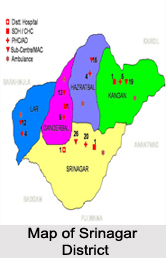 Srinagar District is situated in the centre of Kashmir Valley in the state of Jammu and Kashmir. Srinagar District has 8 assembly constituencies like Hazratbal Shrine, Zadibal, Eidgah, Khanyar, Habbakadal, Amirakadal, Sonwar and Batmaloo, which are now the tourists" delight while visiting Srinagar District. The area of the district is 294 Sq. Kms. Srinagar District is famous for its lakes and houseboats. It is also known for traditional Kashmiri handicrafts and dry fruits. Srinagar is the headquarters of Srinagar district.
Srinagar District is situated in the centre of Kashmir Valley in the state of Jammu and Kashmir. Srinagar District has 8 assembly constituencies like Hazratbal Shrine, Zadibal, Eidgah, Khanyar, Habbakadal, Amirakadal, Sonwar and Batmaloo, which are now the tourists" delight while visiting Srinagar District. The area of the district is 294 Sq. Kms. Srinagar District is famous for its lakes and houseboats. It is also known for traditional Kashmiri handicrafts and dry fruits. Srinagar is the headquarters of Srinagar district.
Location of Srinagar District
Srinagar District is surrounded by five districts. In the north it is flanked by Kargil District and Ganderbal District in the South by Pulwama District, in the north-west by Budgam District. The capital city of Srinagar is located 1585 meters above sea level. The geographical location of Srinagar district is 34 degree 5 minutes 23 seconds North latitude and 74 degree 47 minutes 24 seconds East longitude.
History of Srinagar District
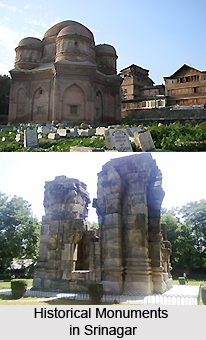 History of Srinagar can be traced back to the ancient ages, around the 3rd century BC. The term Srinagar is a derivation of two Sanskrit words, `Sri` which implies Lakshmi and `Nagar` meaning city. Some historians are of the view that the city of Srinagar had been created by Ashoka, who was a Pandava ruler. There is another account which states that King Ashoka, who was the famous Mauryan king had been the original founder of the city of Srinagar, which was then located near Pandrethan village. This village was based at a distance of nearly 5 km away from the northern portion of the current Srinagar capital.
History of Srinagar can be traced back to the ancient ages, around the 3rd century BC. The term Srinagar is a derivation of two Sanskrit words, `Sri` which implies Lakshmi and `Nagar` meaning city. Some historians are of the view that the city of Srinagar had been created by Ashoka, who was a Pandava ruler. There is another account which states that King Ashoka, who was the famous Mauryan king had been the original founder of the city of Srinagar, which was then located near Pandrethan village. This village was based at a distance of nearly 5 km away from the northern portion of the current Srinagar capital.
Ancient History of Srinagar
Srinagar was known by numerous names in the ancient ages. Certain historical records claim that King Pravarasena II had created Srinagar more than 2,000 years ago and referred to the city as Parvasenpur. During that time, Srinagar was a portion of the Maurya Empire and the religion of Buddhism was ushered here by King Ashoka. Thereafter, Srinagar and the regions surrounding this place became important centres of Buddhism. Around the 1st century, Srinagar was controlled by the Kushanas and numerable kings of Kushana dynasty popularised the traditions and customs of Buddhism in this part of the country. It is believed that King Vikramaditya of the kingdom of Ujjain reigned over this portion of India. This was before the Huns conquered this area in the 6th century. Mihirkula was said to have been the most feared ruler of the Srinagar valley, who was a tyrant. Around the period of 960AD, Srinagar was made the capital of Kashmir.
Medieval History of Srinagar
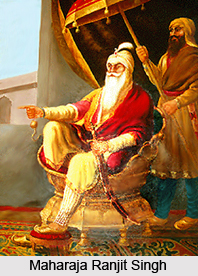 Medieval history of Srinagar involves the political scenario of the region of Srinagar during the regime of the Mughal Dynasty. The 14th century marked the advent of numerable Muslim rulers in the Kashmir valley, which also comprised the Mughals. During the rule of Yusuf Shah Chak, who was an independent Kashmiri king, Srinagar was his capital. However, the Mughal emperor Akbar was able to grab the area of Srinagar from Yusuf Chak by means of forgery when the former failed to do so by force. Yusuf Shah Chak has been buried in the Eastern Indian state of Bihar. Akbar marked the foundation of the Mughal Empire in Kashmir valley.
Medieval history of Srinagar involves the political scenario of the region of Srinagar during the regime of the Mughal Dynasty. The 14th century marked the advent of numerable Muslim rulers in the Kashmir valley, which also comprised the Mughals. During the rule of Yusuf Shah Chak, who was an independent Kashmiri king, Srinagar was his capital. However, the Mughal emperor Akbar was able to grab the area of Srinagar from Yusuf Chak by means of forgery when the former failed to do so by force. Yusuf Shah Chak has been buried in the Eastern Indian state of Bihar. Akbar marked the foundation of the Mughal Empire in Kashmir valley.
After the death of the Mughal emperor Aurangzeb in the year 1707, the Mughal Empire started displaying signs of decline gradually. The decline of the Mughal Dynasty encouraged the infiltrations from Pashtun tribes who entered the Kashmir valley. For many years, Srinagar and other portions of the valley of Kashmir were annexed by the Durrani Empire. A significant part of Kashmir valley was invaded by Maharaja Ranjit Singh, the then ruler of Punjab province in 1814. After that, the Sikhs gained control of Srinagar city. At Lahore, the British and the Sikh kings signed the Treaty of Lahore during 1846. As per the guidelines of this treaty, the British were granted de facto suzerainty over the valley of Kashmir and Gulab Singh was crowned as an independent ruler of Kashmir. Therefore Srinagar was included in his kingdom and held its position as one of the many princely states of the country till the year 1947. The Maharajas who ruled the region of Kashmir used to dwell in Sher Garhi Palace as their main residence of Srinagar.
Modern History of Srinagar
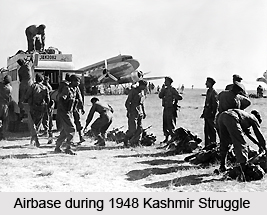 On 17th August, 1947, villagers residing near the Poonch valley rebelled against the continuous rule of the Maharaja, when India had attained independence from the British Raj. Pashtun tribes like `Afridi` and `Mehsud` entered Srinagar from the Pakistan`s Khyber Pakhtunkhwa to conquer it on 22nd October, 1947. However, the Maharaja refused to grant Kashmir either to Pakistan or to India and wanted to rule Kashmir independently and signed the `instrument of accession` during 1947. This accession was accepted by the government of India the following day and Indian army was sent to Srinagar, who obstructed the entry of tribesmen into Srinagar. On 19th January, 1990 Srinagar became the centre for the maximum amount of political turmoil, which resulted in violent protests, strikes, bomb-blasts and curfews fuelled by the Gawakadal Massacre.
On 17th August, 1947, villagers residing near the Poonch valley rebelled against the continuous rule of the Maharaja, when India had attained independence from the British Raj. Pashtun tribes like `Afridi` and `Mehsud` entered Srinagar from the Pakistan`s Khyber Pakhtunkhwa to conquer it on 22nd October, 1947. However, the Maharaja refused to grant Kashmir either to Pakistan or to India and wanted to rule Kashmir independently and signed the `instrument of accession` during 1947. This accession was accepted by the government of India the following day and Indian army was sent to Srinagar, who obstructed the entry of tribesmen into Srinagar. On 19th January, 1990 Srinagar became the centre for the maximum amount of political turmoil, which resulted in violent protests, strikes, bomb-blasts and curfews fuelled by the Gawakadal Massacre.
Geography of Srinagar District
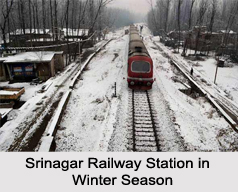 Srinagar lies between two hills, the Hari Parbat and the Shankaracharya (also known as Takht-i-Suleiman). The city had experienced several natural disasters. Before the nineteenth century, Srinagar had been destroyed and rebuilt six times. Two major fires, in 1892 and 1899, devastated large portions of the city. There have been eleven major earthquakes in the city since the fifteenth century. The city has mild summers during the months April-June and cold winters of November-February. The city generally gets heavy snowfall from December to February. Temperature lies within 29.5 degree centigrade to -1.9 degree centigrade. Best time to visit is the months from April to June.
Srinagar lies between two hills, the Hari Parbat and the Shankaracharya (also known as Takht-i-Suleiman). The city had experienced several natural disasters. Before the nineteenth century, Srinagar had been destroyed and rebuilt six times. Two major fires, in 1892 and 1899, devastated large portions of the city. There have been eleven major earthquakes in the city since the fifteenth century. The city has mild summers during the months April-June and cold winters of November-February. The city generally gets heavy snowfall from December to February. Temperature lies within 29.5 degree centigrade to -1.9 degree centigrade. Best time to visit is the months from April to June.
Demography of Srinagar District
According to the Population Census in the year 2011, Srinagar district has a population of 1,269,751. This gives it a ranking of 381st in India (out of a total of 640). Srinagar district has a population density of 703 inhabitants per square kilometer (1,820/sq mi). The population growth rate over the decade 2001-2011 in Srinagar district was 23.56%. Srinagar district has a sex ratio of 879 females for every 1000 males, and a literacy rate of 71.21%.
Administration of Srinagar District
Srinagar District comprises two tehsils or towns viz Srinagar North and Srinagar South, one block (Srinagar), besides 136 Revenue villages. Srinagar Municipal Committee runs the city. The district contributes 2 parliamentary seats-Srinagar city and Badgam.
Economy of Srinagar District
Srinagar District is the main centre of the economy of the Kashmir Valley, and has remained tourist destination for centuries. Significant segment of the economy include handicrafts, weaving of woollen shawls and dress material and woodcarving. Srinagar serves as one of the collecting point from where fruits and handicraft products are taken to several parts of Indian subcontinent. Srinagar also has specialised markets and retail shops. The hinterland of Srinagar is the most populous part of the Kashmir valley, and crops like wheat and paddy are cultivated for local consumption. Orchards produce a number of fruits, particularly apples.
Education in Srinagar District
There are around two hundred and forty two primary schools, one hundred and thirty six middle schools and seventy three higher secondary schools. Mainly there are army and air force schools. Apart from them main well-known schools are D.P.S, J&K Public school and Kendriya Vidyalaya. The education boards in the city are J&K state board, C.B.S.E and ICSE. There are six degree college and five professional colleges in this district.
Culture of Srinagar District
Srinagar District has a distinctive blend of cultural heritage. Holy places in and around the city depict the historical cultural and religious diversity of the city as well as Kashmir valley. Bhand Pather is a form of traditional folk theatre art form of play and dance. The artists depict in a satirical style social evils. Chakri is a form of Kashmiri folk music and is the most popular in the district. Another very well known form of Kashmiri music is Sufiana music. The instruments used in the music include Santoor, Sitar, Kashmiri Saz, Tabla and Wasool. Hafiz Nagma is a form of Dance that is performed to the accompaniment of Sufiana music.
Cuisine of Srinagar District
Cuisine of Srinagar District is redolent with the flavour of the spices used -cinnamon, cardamom, cloves, saffron, etc. The staple diet of people in the district is rice; the most preferred being the dense, slightly sticky grained Kashmir variety, which is prized in the Valley. Mutton, chicken or fish are of prime importance in Kashmiri meal and everyday cooking often combines vegetable and meat in the same dish. Mutton and turnips, chicken and spinach, fish and lotus root are also very popular combinations. Pure vegetarian dishes include dum-aloo, i.e. roasted potatoes in curd-based gravy, and chaman- fried paneer (cottage cheese), in a thick sauce.
Tourism in Srinagar District
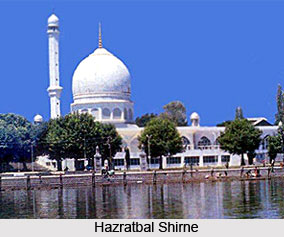 Tourism in Srinagar District offers visits to several ancient places as well as religious sites. Moreover, there are a wide array of lakes and beautiful gardens in Srinagar District that are worth visiting. Srinagar District is known for its amazing beauty and people from all parts of the country come to explore its magnificent beauty. Some of the popular tourism options of Srinagar District are as follows -
Tourism in Srinagar District offers visits to several ancient places as well as religious sites. Moreover, there are a wide array of lakes and beautiful gardens in Srinagar District that are worth visiting. Srinagar District is known for its amazing beauty and people from all parts of the country come to explore its magnificent beauty. Some of the popular tourism options of Srinagar District are as follows -
Pilgrimage Tourism in Srinagar District
Hazratbal Shirne: Hazrathalbal Shirne, which is situated on the left bank of the famous Dal Lake in Srinagar. This holy shirne is known by several names including Hazratbal, Assar-e-Sharief, madinat-us-Sani and Dargah. The construction of the present marble structure was started by the Muslim Aquaf Trust headed by Sheikh Mohammad Abdullah in the year 1968 and was completed in 1979. The Moi-e-Muqqadas is displayed on various occasions associated with the life of the Prophet and his four holy companions.
Shankaracharya Temple: It is located at 1100 ft above the surface level of the main city on the Shankaracharya hill, also known as Takht-e-Suleiman. The Shiva temple was constructed by Raja Gopadatya in 371 B.C and it is one of the ancient holy sites in Kashmir. Dogra ruler, Maharaja Gulab Singh, constructed stone stairs up to the temple. The temple is a prominent religious place of the place and is of great archaeological importance. The temple commands a magnificent panoramic view of Srinagar city.
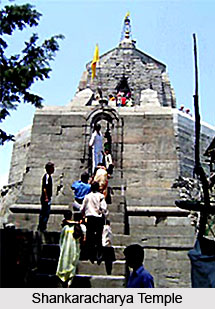 Khanqah-e-Molla: The shrine of Shah-e-Hamdan or Khanqah-e-Moulla is one of the oldest Muslim shrines in Kashmir situated on the bank of Jhelum River in the old city
Khanqah-e-Molla: The shrine of Shah-e-Hamdan or Khanqah-e-Moulla is one of the oldest Muslim shrines in Kashmir situated on the bank of Jhelum River in the old city
Jama Masjid: It is one of the oldest and the most spacious of all the mosques in Kashmir, situated in the heart of the city. The foundation of the mosque, an architectural wonder was laid by Sultan Sikander in 1398 A.D. The area of the mosque is really spacious and is enough for over thirty thousand people to offer prayer at a time
Imambara Hassanabad: The 2nd oldest shrine in Jammu and Kashmir is Imambara Hassanabad situated in south west of city centre Lal Chowk. The Imam Bargah is surrounded by world famous Hazratbal shrine on one side, Temple of Mata Sharka Devi and Gurdawara Chatti Padshahi on other side.
Chatti Padshahi: Chatti Padshahi, one of the most important Sikh Gurudwaras in Kashmir. The sixth guru of Sikhism travelled through Kashmir, stopping to preach occasionally. It is situated just outside the southern gate of Hari Parbat fort.
Leisure Tourism in Srinagar District
Cheshma Shahi and Pari Mahal: Cheshma Shahi or the Royal Spring was laid by Shah Jahan in 1632 A.D. It is 9 km from the city centre and is famous for a spring of refreshment water. Two kilometres uphill from Cheshma Shahi is situated the Pari Mahal, a school of astrology founded by Dara Shikoh. The Cheshma Shahi-Pari Mahal area has been developed into a tourist village.
Nature Tourism in Srinagar District
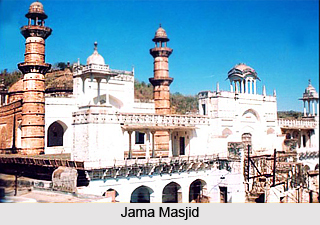 Nishat Garden: This garden is situated on the banks of the Dal Lake in the backdrop of the Zabarwan hills; 11 km from the district headquarter of Srinagar. The Garden commands a magnificent view of the lake.
Nishat Garden: This garden is situated on the banks of the Dal Lake in the backdrop of the Zabarwan hills; 11 km from the district headquarter of Srinagar. The Garden commands a magnificent view of the lake.
Shalimar Garden: The garden, 15 kms from the city centre, was built by Mughal Emperor Jahangir for his beloved wife, Nur Jahan. The garden with four terraces is 539 by 182 metres and gets water from Harwan through a canal lined with fountains. The fourth terrace was once reserved for royal ladies.
Dal Lake: The world famous water body described by Sir Walter Lawerence as the `Lake par-excellence`, half a kilometre from the city, is the jewel in the crown of Kashmir eulogised by the poets and hugely praised by the travellers and tourists. The lake of late has unfortunately, considerably shrunk in size causing concern to environmentalists. Two islands, Sona Lank and Ropa Lank, within the lake add to its beauty. Nagin Lake is the loveliest part of the Dal Lake separated by a causeway.
Dachigam National Park: Dachigam National Park is a wildlife sanctuary which is home to the endangered Hangul species of Deer in the country. Dachigam is also the habitat to other wildlife of the state namely Black Bear, Musk Deer, leopards and several migratory birds. There is also a Trout fish farm in Dachigam. It is big natural reserve which requires permissions from the Wildlife Authorities for exploration. The dense forests of Dachigam offer a brilliant view along with a Glacier fed rivulet flowing right through the middle.
 Tourist places around Srinagar include some of the well known sites which not only define the traditional growth of the civilization but also reflect the scenic beauty that surrounds the city of Srinagar.
Tourist places around Srinagar include some of the well known sites which not only define the traditional growth of the civilization but also reflect the scenic beauty that surrounds the city of Srinagar.
Among the prominent places there are some well known gardens and waterfalls like Achadel, Anantanag and Kokarnag and Verinag; along with some ancient historical sights like Avantipuram, Burznhom and Chichari Slicirif; and sights for tourism like Gulmarg and Dachigam wild life sanctuary which attract a large number of tourists every year.
Mughal Gardens
Tourist places around Srinagar include a unique place called "Achadel" which is one of the popular Mughal Gardens located at a distance of 6 kms from Srinagar. This is situated at a height of 1677 meters which was made for Empress Nur Jahan. This garden is well known for exhibiting nature`s beauty in such a way that attracted Nur Jahan who was a great patron of beauty and gardens. Designed by Akashbal this garden is known for the Irout hatchery and the tourists` bungalows which attract the tourist who can enjoy a splendid holiday in this place.
Anantanag
Along with Mughal Gardens, there are other tourist spots around Srinagar which include places like Anantanag. This place is mainly known for the two fresh water streams that flow through Himalayan regions. The place is one of the most popular sights around Srinagar which is famous for a number of legends. Anantanag literally means the main stream which is made up of a number of streams. It includes some streams like Nag bal, Salak nag and Malik nag which flow towards the town. It is considered to be last stream of Kashmir valley which opens the way for Amarnath. Along with this Anantanag is also known as one of historical sights around Srinagar. Anatanag is famous for number of legends which has been mentioned in Bhagvat gita and chronicles of Nags and pichash. Overall the place is known for the temples of Lord Shiva and Radhakrishna which is situated amidst the two fresh water streams. Anantanag is an important archeological sight of India as well. With the ancient temple of Martand Temple this place reveals the cultural heritage of ancient past.
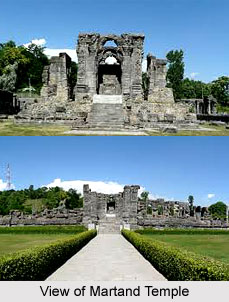
Avantipur
Among the historical sights around Srinagar there are some more places like the sites of Avantipur which has the popular shrine of Lord Shiva. This was developed by Hindu ruler AvantiVerman in 9th century who developed this area as the ancient capital of Kashmir valley. Along with this there are some sites at Burznhom which has been excavated by Archaeological survey of India. This area revealed the existence of ancient civilization in the area which can be dated back to 2500BC. This sight is located at a distance of 24 kms from Srinagar. Charari- Sharief is another site which is known for the celebrated shrine of saint Sheikh Noor-ud-Bin. While these are some of the historical sights which have been valuable sources that reveal the past of Jammu and Kashmir and the ancient civilization that resided in these areas, there are some tourist spots like Gulmarg, Sonamarg and Dachigam Wildlife sanctuary which attract a large number of crowd in every season.
Gulmarg
`Paradise on Earth`- Kashmir also include some picturesque sites like Gulmarg which is one of the important tourist places around Srinagar. Gulmarg remains completely covered with snow during the winters and provide great facilities for picnic during the summer season. In both the seasons it attracts a large number of tourists who enjoy the scenic beauty of the area from an altitude of 2730 meters. The oval shaped meadows of Gulmarg are located at a distance of 51 kms from Srinagar.
Dachigam Wildlife Sanctuary
Along with the Pine forests of Gulmarg there is the attractive wild life sanctuary of Dachigam that preserves the rare species of wild life. Overall the tourist spots located around Srinagar provide a lot of entertainment to its visitors who have a variety of places to visit. While some are known for the legends which are mentioned in various literary texts, the other places are known for the scenic beauty.
Ganesh Temple - Srinagar
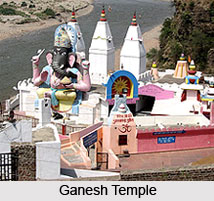 The Ganesh Temple, located in Srinagar city, is a well-known gothic shrine. The idol of Lord Ganesh that was saved from the attack of the Pathan rulers is established at the outer shrine of the temple, adjoining a Shivalingam (the symbolic phallus representation of Lord Shiva). The central shrine contains two larger idols of Lord Ganesh. The temple is adeptly managed by a local managing committee. Vaisakha Shukla Chaturdashi and a Mahayajna (sacred ritual) performed by the Brahman Maha Mandal organisation are the annual festivals celebrated in the Ganesh temple.
The Ganesh Temple, located in Srinagar city, is a well-known gothic shrine. The idol of Lord Ganesh that was saved from the attack of the Pathan rulers is established at the outer shrine of the temple, adjoining a Shivalingam (the symbolic phallus representation of Lord Shiva). The central shrine contains two larger idols of Lord Ganesh. The temple is adeptly managed by a local managing committee. Vaisakha Shukla Chaturdashi and a Mahayajna (sacred ritual) performed by the Brahman Maha Mandal organisation are the annual festivals celebrated in the Ganesh temple.
Monuments in Srinagar
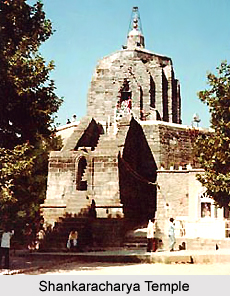 Srinagar is defined as the city of elegance and great antiquity. It is the summer capital city of Jammu and Kashmir and is located at the Kashmir Valley. It stands at a height of (5,227 ft) on the Dal Lake and Jhelum River. Srinagar is popular for its picturesque scenic beauty, simmering lakes and beautiful houseboats and also for its dry fruits and traditional handicrafts. It is a popular tourist place in itself and is also used as a stepping-stone to Ladakh. Amidst all that, Srinagar is also known for the presence of some ancient monuments that are historically significant.
Srinagar is defined as the city of elegance and great antiquity. It is the summer capital city of Jammu and Kashmir and is located at the Kashmir Valley. It stands at a height of (5,227 ft) on the Dal Lake and Jhelum River. Srinagar is popular for its picturesque scenic beauty, simmering lakes and beautiful houseboats and also for its dry fruits and traditional handicrafts. It is a popular tourist place in itself and is also used as a stepping-stone to Ladakh. Amidst all that, Srinagar is also known for the presence of some ancient monuments that are historically significant.
Historical monuments in Srinagar
Srinagar has a rich religious and political history. Being inhabited by several religions and ruled by different dynasties in the bygone eras, Srinagar boasts of some magnificent historical remnants.
Shankaracharya Temple
Shankaracharya Temple is one of the major monuments of Srinagar. It is located on the hill called `Takht-e-Suleiman` at a height of almost 1100 ft. above the surface level. This temple was constructed by Raja Gopadatya in 371 BC, and he gave it the name of `Gopadri`. It is believed that great philosopher `Shankaracharya` stayed here during his visit to Kashmir for reviving `Sanatan Dharma`. This incident eventually led to the renaming of this temple as its present one. This temple is dedicated to God Shiva and it is actually the oldest place of worship in the valley of Kashmir.
Hazratbal Shrine
Hazratbal Shrine, a Muslim shrine of this city is one of its most renowned monuments. This important Islamic shrine is situated on the banks of Dal Lake. The origin of its name comes from `Hazrat`, an Arabic word that means majestic and pure and from the Kashmiri term `bal`, which means place. It is believed to have existed since the 18th century.
Jama Masjid
Another popular monument of Srinagar is `Jama Masjid`. This mosque is situated at the centre of the old city. It is considered as an important mosque and it was founded by Sultan Sikandar in 1400 AD. This mosque reflects wonderful Indo-Saracenic architecture. It has four arched openings in the centre of each side covered with pyramidal roofs. There are three pagoda-shaped minarets and over 370 pillars support the roof, each made of deodar tree trunk.
Mosque of Akhund Mulla Shah
`Mosque of Akhund Mulla Shah` was built in the year 1649 by Shah Jahan`s son. It is really unique and unusual as it was built in stone rather than wood and externally it has rectangular panels enclosing cusped arches.
Shah Hamadan
There is another fine mosque called the `Shah Hamadan`. It reflects the typical wooden style of architecture of Kashmir. The stonework plinth is composed of old temple fragments while the body of the mosque is a simple cube covered by a pagoda-like roof. It was first built in 1395 CE, commissioned by Sultan Sikendar.
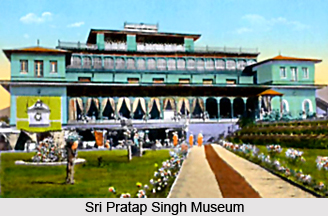 Kheer Bhawani
Kheer Bhawani
Another popular monument of this magnificent city is `Kheer Bhawani`. This temple is devoted to goddess "Kheer Bhawani". This temple is located near the village of Tula Mula over a sacred spring. The date of construction of this monument is unknown.
Pattar Masjid
The old Pattar Masjid, built in 1623 reflects provincial Mughal style. It was actually dedicated to Empress Nur Jahan and was built under the supervision of the architect Malik Haidar Chaudara. It is now used as a granary.
Pari Mahal
In the year 1635, Dara Shukoh, eldest son of Shah Jahan, built the Pari Mahal or the Palace of Fairies. It was reputed to have been a school of astrology but is now in ruins. Five terraces of this palace can still be seen along with the remains of fountains and tanks behind the ruined facade which lie on an inaccessible spur of rock.
Hari Parbat Fort
Hari Parbat is also known as Sharika Peeth among the Hindus and locally known as Koh-e-Maran. The first part of the fort was built by the Mughal Emperor Akbar in the year 1590. During this time Akbar built the outer wall of the fort. As Emperor Akbar left his job undone, later on in 18th century the construction of this fort was completed by Atta Muhammad Khan who was an Afghan Governor.
Sher Garhi Palace
Sher Garhi Palace is located in the southern parts of river Jhelum and is an important landmark of this beautiful city. Sher Garhi stands for tiger fortress. It was in the year 1722 when Jawansher Khan the Afghan Governor constructed this place and named it as Sher Garhi Palace.
Sri Pratap Singh Museum
Sri Pratap Singh Museum houses a collection of over 80,000 objects from various regions in Northern India. It exhibits interesting collection of Kashmiri relics in different forms like objects, crafts, etc. This archeological museum, also known as SPS Museum, was established in 1898.
Visiting Information
Srinagar is linked with New Delhi through Jammu. It is also connected to Leh District, Mumbai, Chandigarh and Bengaluru. The nearest railway station is Udhampur (230 km). The roads to Chandigarh, Jammu, Sonamarg, Pahalgam, Delhi, Leh, Kargil and Gulmarg links Srinagar. The main Bus Station is at Lal Chowk.



















